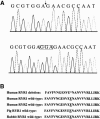Single-amino-acid deletion in the RYR1 gene, associated with malignant hyperthermia susceptibility and unusual contraction phenotype
- PMID: 11389482
- PMCID: PMC1226035
- DOI: 10.1086/321270
Single-amino-acid deletion in the RYR1 gene, associated with malignant hyperthermia susceptibility and unusual contraction phenotype
Abstract
Malignant hyperthermia (MH) is an anesthetic-drug-induced, life-threatening hypermetabolic syndrome caused by abnormal calcium regulation in skeletal muscle. Often inherited as an autosomal dominant trait, MH has linkage to 30 different mutations in the RYR1 gene, which encodes a calcium-release-channel protein found in the sarcoplasmic reticulum membrane in skeletal muscle. All published RYR1 mutations exclusively represent single-nucleotide changes. The present report documents, in exon 44 of RYR1 in two unrelated, MH-susceptible families, a 3-bp deletion that results in deletion of a conserved glutamic acid at position 2347. This is the first deletion, in RYR1, found to be associated with MH susceptibility. MH susceptibility was confirmed among some family members by in vitro diagnostic pharmacological contracture testing of biopsied skeletal muscle. Although a single-amino-acid deletion appears to be a subtle change in the protein, the deletion of Glu2347 from RYR1 produces an unusually large electrically evoked contraction tension in MH-positive individuals, suggesting that this deletion produces an alteration in skeletal-muscle calcium regulation, even in the absence of pharmacological agents.
Figures



Similar articles
-
Autosomal dominant canine malignant hyperthermia is caused by a mutation in the gene encoding the skeletal muscle calcium release channel (RYR1).Anesthesiology. 2001 Sep;95(3):716-25. doi: 10.1097/00000542-200109000-00026. Anesthesiology. 2001. PMID: 11575546
-
Ryanodine receptor mutations in malignant hyperthermia and central core disease.Hum Mutat. 2000;15(5):410-7. doi: 10.1002/(SICI)1098-1004(200005)15:5<410::AID-HUMU2>3.0.CO;2-D. Hum Mutat. 2000. PMID: 10790202 Review.
-
Screening for mutations in the RYR1 gene in families with malignant hyperthermia.J Mol Neurosci. 2003;21(1):35-42. doi: 10.1385/JMN:21:1:35. J Mol Neurosci. 2003. PMID: 14500992
-
A case of discordance between genotype and phenotype in a malignant hyperthermia family.Eur J Hum Genet. 1999 May-Jun;7(4):415-20. doi: 10.1038/sj.ejhg.5200314. Eur J Hum Genet. 1999. PMID: 10352931
-
Genetics of malignant hyperthermia.ScientificWorldJournal. 2006 Dec 28;6:1722-30. doi: 10.1100/tsw.2006.289. ScientificWorldJournal. 2006. PMID: 17195870 Free PMC article. Review.
Cited by
-
Malignant hyperthermia.Orphanet J Rare Dis. 2007 Apr 24;2:21. doi: 10.1186/1750-1172-2-21. Orphanet J Rare Dis. 2007. PMID: 17456235 Free PMC article. Review.
-
Whole exome sequencing of a patient with suspected mitochondrial myopathy reveals novel compound heterozygous variants in RYR1.Mol Genet Genomic Med. 2017 Mar 30;5(3):295-302. doi: 10.1002/mgg3.280. eCollection 2017 May. Mol Genet Genomic Med. 2017. PMID: 28547000 Free PMC article.
-
Basal bioenergetic abnormalities in skeletal muscle from ryanodine receptor malignant hyperthermia-susceptible R163C knock-in mice.J Biol Chem. 2011 Jan 7;286(1):99-113. doi: 10.1074/jbc.M110.153247. Epub 2010 Oct 26. J Biol Chem. 2011. PMID: 20978128 Free PMC article.
-
Functional analysis of RYR1 variants linked to malignant hyperthermia.Temperature (Austin). 2016 Feb 26;3(2):328-339. doi: 10.1080/23328940.2016.1153360. eCollection 2016 Apr-Jun. Temperature (Austin). 2016. PMID: 27857962 Free PMC article.
-
An integrated approach to the evaluation of patients with asymptomatic or minimally symptomatic hyperCKemia.Muscle Nerve. 2022 Jan;65(1):96-104. doi: 10.1002/mus.27448. Epub 2021 Nov 8. Muscle Nerve. 2022. PMID: 34687219 Free PMC article.
References
Electronic-Database Information
-
- Center for Medical Genetics, Marshfield Medical Research Foundation, http://research.marshfieldclinic.org/genetics/ (for chromosome 19 markers)
-
- GenBank, http://www.ncbi.nlm.nih.gov/Genbank/ (for human skeletal-muscle RYR1 exon 44 sequence [accession number U48477], RYR1 sequence [accession number J05200], cardiac-muscle RYR2 sequence [accession number X98330], dog skeletal-muscle RYR1 sequence [accession numbers AF302182 and AF302129], and pig skeletal-muscle RYR1 sequence [accession number M91452])
-
- Online Mendelian Inheritance in Man (OMIM), http://www.ncbi.nlm.nih.gov/Omim/ (for MH [MIM 145600], human RYR1 [MIM 180901], and central core disease [MIM 117000])
References
-
- Allen GC, Larach MG, Kunselman AR (1998) The sensitivity and specificity of the caffeine-halothane contracture test. Anesthesiology 88:579–588 - PubMed
-
- Allen PD, Ryan JF, Jones DE, Mabuchi K, Virga A, Roberts J, Sreter F (1986) Sarcoplasmic reticulum calcium uptake in cryostat section of skeletal muscle from malignant hyperthermia patients and controls. Muscle Nerve 5:474–475 - PubMed
-
- Brown RL, Pollock AN, Couchman KG, Hodges M, Hutchinson DO, Waaka R, Lynch P, McCarty TV, Stowell KM (2000) A novel ryanodine receptor mutation and genotype-phenotype correlation in a large malignant hyperthermia New Zealand Maori pedigree. Hum Mol Genet 9:1515–1524 - PubMed
-
- Chamley D, Pollock NA, Stowell KM, Brown RL (2000) Malignant hyperthermia in infancy and identification of novel RYR1 mutation. Br J Anaesth 84:500–504 - PubMed
-
- Etchrivi TS, Adnet PJ, Tavernier B, Diallo A, Haudecoeur G, Krivosic-Horber RM (1998) Effects of halothane on mechanical response of skeletal muscle from malignant hyperthermia susceptible patients. Arch Physiol Biochem 106:1–7 - PubMed
MeSH terms
Substances
LinkOut - more resources
Full Text Sources
Other Literature Sources
Molecular Biology Databases

